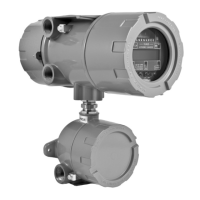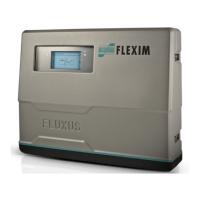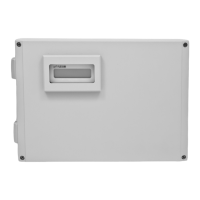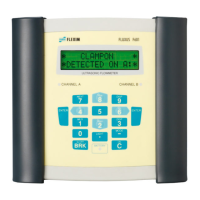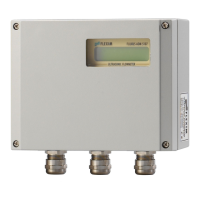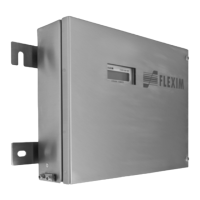Do you have a question about the Flexim FLUXUS F809 A1 Series and is the answer not in the manual?
| Brand | Flexim |
|---|---|
| Model | FLUXUS F809 A1 Series |
| Category | Measuring Instruments |
| Language | English |
Outlines notation for safety and general precautions for using the instrument.
Essential handling precautions for correct measurement and damage avoidance.
Explains TransitTime and NoiseTrek modes, defining key terms like flow profile.
Details how flow velocity is measured using the TransitTime principle and the calculation formula.
Explains flow velocity measurement in NoiseTrek mode for fluids with gas bubbles or solids.
Explains the requirement for the pipe and fluid to allow sound signal transmission for measurement.
Explains how flow elements distort the profile and the importance of selecting measuring points away from disturbances.
Guides connecting transducer cables to the transmitter for the F808**-A1 model.
Guides connecting transducer cables to the transmitter for the F808**-F1 model.
Guides connecting transducer cables to the transmitter for the F808**-F2 model.
Details connecting transducer cables with SMB connectors to the transmitter via an adapter.
Guides selecting the measuring point and transmitter location considering ambient conditions.
Details connecting cables to the transmitter, emphasizing safety and enclosure integrity.
Guides connecting transducer cables to the transmitter for the F809**-A1 model.
Details connecting transducer cables with plastic jackets to the transmitter.
Guides connecting extension cables to the transmitter, emphasizing shielding for high frequencies.
Guides connecting transducer cables to the transmitter for the F809**-F1 model.
Details connecting transducer cables through conduit to the transmitter.
Details connecting the power supply to the transmitter, including safety requirements for switches.
Details connecting output cables to the transmitter and output configurations.
Explains the role of the sensor module and the importance of matching serial numbers.
Details cleaning the pipe surface and ensuring good acoustic contact for transducer mounting.
Guides on mounting transducers, their orientation, and determining the correct distance.
Describes using the PermaFiX fixture for hazardous locations, including installation with bolts or tension straps.
Outlines initial settings required when starting the transmitter for the first time.
Explains how to perform a transmitter initialization to reset settings to default values.
Guides on entering pipe parameters like diameter, wall thickness, and material.
Guides on entering fluid parameters like sound speed, viscosity, density, temperature, and pressure.
Explains setting the transducer distance for optimal measurement.
Details how to fine-tune the transducer distance based on signal amplitude and quality.
Explains how to perform a consistency check of transducer distance against measured sound speed.
Explains how to start the measurement process, including multiplexer operation.
Guides on selecting the physical quantity and its unit for display and transmission.
Explains how to interpret the status line for important measurement data and quality indicators.
Describes the FastFood mode for measuring flows with high dynamics.
Guides on defining calculation functions using measuring channels and operators.
Lists the types of data stored by the transmitter's data logger.
Explains transmitting measurement data to a PC via serial interface RS232 or RS485.
Details configuring transmission parameters (baud rate, parity, bits) for RS232 and RS485.
Explains activating and using the extended library for temperature/pressure dependent parameters.
Explains how to activate and deactivate the SuperUser mode using HotCodes.
Guides on defining flow parameters like profile bounds and flow velocity correction.
Details how to correct flow velocity using slope and offset based on profile bounds.
Guides on installing and activating outputs, including channel and source item assignment.
Details defining the output range for analog outputs, including manual entry.
Explains defining error values to be output when measurements are not possible.
Guides on activating analog outputs after installation and setting their measuring range.
Details setting the zero-scale and full-scale values for analog outputs.
Guides on testing the function of installed analog outputs with a multimeter.
Explains configuring frequency outputs to act as pulse outputs for totalizing.
Explains activating binary outputs as pulse outputs for integrating fluid passing a threshold.
Guides on activating binary outputs as alarm outputs for monitoring measurement conditions.
Details defining alarm properties like switching condition, holding behavior, and function.
Explains setting upper and lower limits for alarm conditions (MAX, MIN, QUANT.).
Addresses issues like no signal, wrong parameters, and incorrect transducer distance.
Provides guidelines for selecting an appropriate measuring point to avoid issues.
Discusses potential causes for large deviations like wrong sound speed, gas in pipe, or incorrect parameters.
Details configuring and activating pulse outputs.
Guides on activating and configuring alarm outputs.
Covers settings related to WaveInjector, NoiseTrek, flow velocity limits, and cut-off flow.
